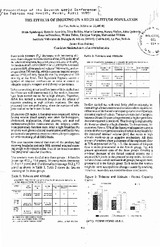Mostrar el registro sencillo del ítem
The effects of smoking on a high altitude population. (La Paz, Bolivia, 3600m or 12,200ft)
| dc.contributor.author | Spielvogel, Hilde | |
| dc.contributor.author | Aparicio, Octavio | |
| dc.contributor.author | Bellido, Diva | |
| dc.contributor.author | Galarza, Mario | |
| dc.contributor.author | Nallar, Nancy | |
| dc.contributor.author | Quintela, Aida | |
| dc.contributor.author | Peñaloza, Rosario | |
| dc.contributor.author | Tellez, Wilma | |
| dc.contributor.author | Vargas, Enrique | |
| dc.contributor.author | Villena, Mercedes | |
| dc.date.accessioned | 2017-06-28T15:48:12Z | |
| dc.date.available | 2017-06-28T15:48:12Z | |
| dc.date.issued | 1990 | |
| dc.identifier.uri | http://repositorio.umsa.bo/xmlui/handle/123456789/11007 | |
| dc.description.abstract | Barometric pressure (PB) decreases with increasing a altitude. Since oxygen concentration is about 21% in the air of the whole atmosphere, its partial pressure is also 21% of PB. At the altitude of La Paz (3600)m or 12,200ft) Pb is reduced to almost 60% of the sea level value of 760 mm Hg, and averages about 500 mm Hg, which causes an inspired oxygen tension (P102) of only about 95 mm Hg compared to 150 nm Hg at sea level. This hypobaric hypoxia causes a n umber of adaptive mechanisms in order to ensure an adequate oxygen transport and delivery to the tissues. | es_ES |
| dc.language.iso | en | es_ES |
| dc.publisher | Tobacco and Health | es_ES |
| dc.subject | EFECTOS DEL TABAQUISMO | es_ES |
| dc.subject | GRAN ALTURA | es_ES |
| dc.subject | LA PAZ, BOLIVIA | es_ES |
| dc.title | The effects of smoking on a high altitude population. (La Paz, Bolivia, 3600m or 12,200ft) | es_ES |
| dc.type | Article | es_ES |

